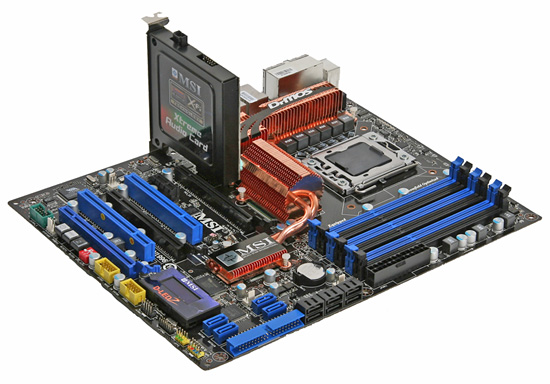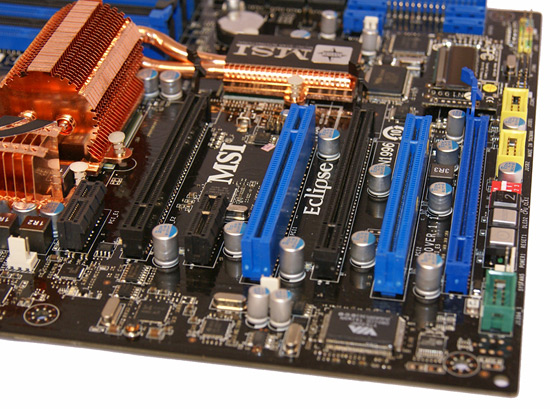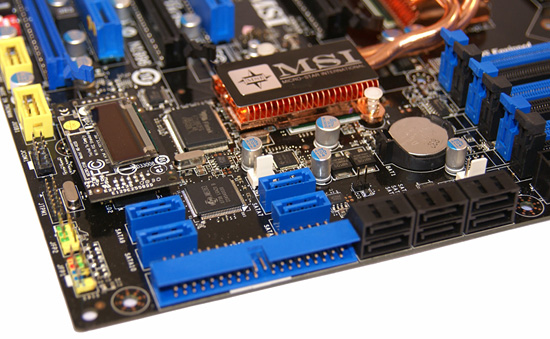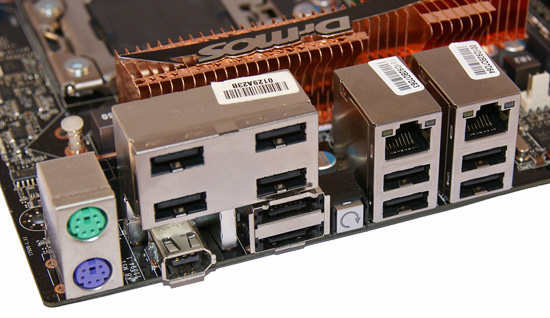MSI X58 Eclipse - First Look
by Gary Key on October 26, 2008 12:00 AM EST- Posted in
- Gary's First Looks
We are rapidly approaching the i7 Core and X58 launch date. With that in mind, we are starting to receive final production motherboards from a variety of manufacturers. The latest board in the labs is the MSI Eclipse featuring the X58 and ICH10R chipsets. Let's take a quick look at it.

MSI has dropped the circu-pipe (roller coaster theme) heatsink design and Crayola colors for a more traditional cooling system complimented by a very sharp looking blue/black color palette. In fact, the layout of the X58 Eclipse is one of the best we have seen in a long time with all ports and slots easily accessed.
We are not crazy about the X58 heatsink design as it resembles a small coffin when viewed up close. MSI is not going to change the design this late in the game but we should see a nice black plate attached to the top of it to match the ICH10R and MOSFET heatsinks before retail shipment. At least we hope...
The board features MSI's DrMOS MOSFET + Driver IC 6-phase power source design. In addition to DrMOS, there is a healthy smattering of solid aluminum capped capacitors, Hi-C capacitors around the CPU area, sealed ferrite chokes, and the PMWs are powered by the Intersil ISL6336.
Audio is provided by a PCIe x1 based Creative X-FI audio controller on a breakout card. While not the latest X-FI chipset from Creative, this one still supports EAX 5.0, provides 8-channel output, is spec'd at 100dB SNR with 24-bit / 96KHz capability. A welcome change from the Realtek ALC-888/885 product family.
Also included is power, reset, and DLED2 on/off switches. MSI is providing a dip-switch for changing the base clock speeds to 133, 166, or 200 MHz at POST time. The board also features several LED status indicators for everything from standby mode to QPI phase status.

MSI has provided a very good PCI/PCI Express slot layout. The Eclipse features three PCIe 2.0 x16 slots (two x16 and one x4 electrical), two PCIe x1 slots and two PCI slots.

This board features extensive storage options. We get a total of ten SATA and two eSATA ports. The SATA ports are provided by the Intel ICH10R (six - black - RAID 0,1,5,10) and a pair of JMicron JMB322 chipsets (four - blue - RAID 0,1, JBOD). A JMicron JMB363 provides IDE support and the two eSATA (RAID 0,1) ports. IEEE 1394a support is provided by the VIA VT6308P.

The I/O panel features eight of the available twelve USB 2.0 ports, an IEEE 1394a port, two eSATA ports, two RJ-45 (Realtek 8111C) PCIe Gigabit ports, PS/2 keyboard/mouse ports, and a long overdue clear CMOS button.
That is our quick look for today, we will be back shortly with additional component details, a BIOS guide, and performance results.
















38 Comments
View All Comments
HollyDOL - Monday, October 27, 2008 - link
Well, I don't have any good speakers setup (Genius Home Theatre), but can tell bitrate of MP3s just by listening to it (CBR).But, considering your post... Do you think your current solution plays well? Then I suggest you borrow X-Fi card from your friend, play some music and try switching between that "PC speaker offspring" and a lil bit better playing card. Doubt you couldn't tell the difference. Even my badly hearing father was able to tell the difference between Audigy and Audigy2 cards and they were both miles better playing than mobo solutions.
It's like driving the car... Let's say you drive new beatle... Ye, it drives well... Until you sit in newest Ferrari.
plonk420 - Monday, October 27, 2008 - link
hate to break it to you, but CBR MP3s are a thing of 4+ years ago.not that i care whether or not you can tell .. and how well you can tell, you can test your own ears (and possibly improve the mp3 encoder that's good enough for the other 98% of people) at a double blind test here: http://www.hydrogenaudio.org/forums/index.php?show...">http://www.hydrogenaudio.org/forums/index.php?show... ...if you CAN tell, and care to share the results, you can even include your nick! ...but that's SO MUCH work to repell trolls on the internet...
i'll consider getting the breakout box version of the X-Fi just to humor you (and other X-Fi zealots) if i come out ahead enough monetarily after a hardware shuffle... all i can say is that everyone i've talked to (across multiple mediums) that favors the X-Fi only does so because of the DSPs
nipplefish - Monday, October 27, 2008 - link
AFAIK a 320kbps CBR will be technically better quality than a V0 VBR encode in LAME. Sure, most people can't tell the difference. But the way I see it, storage is about 10 cents a gigabyte now, so why not encode in the highest possible bitrate anyway?crimson117 - Monday, October 27, 2008 - link
Yes, and why not just go lossless?plonk420 - Tuesday, October 28, 2008 - link
if your ears benefit from the 4x increase in storage needs, more power to you.Aquila76 - Monday, October 27, 2008 - link
Does anybody who would be shelling out approx. $300 for this motherboard actually still have a PS2 keyboard and/or mouse? They must be disappointed that there are no AGP slots!9nails - Monday, October 27, 2008 - link
Some of my servers crash when I remote on to them with a USB mouse. The PNP causes the crash. Using PS2 is the fix. Not that this is a typical situation by any measure, but it is a valid example and justifies PS2 ports for my needs.androticus - Monday, October 27, 2008 - link
Stop dissing compatibility. Your comment about AGP is absurd, because of course no one uses that now, but lots of people still have PS2 keyboards or mice, and it is nice to have the option, for example, to use a KVM box (I have one, and require to use PS2).strikeback03 - Monday, October 27, 2008 - link
IIRC some people figure the PS/2 connected keyboard/mouse are more stable with overclocking.As far as the AGP thing goes, somebody was asking for an AGP HD4830 in the comments of the launch article. I would think that any processors from that generation would struggle to put that GPU to full use, but there are still at least a few people asking for them.
Griswold - Monday, October 27, 2008 - link
You're right with most of what you say, but theres no need to exaggerate by claiming nobody is still using AGP. There are probably more people interested in buying todays low to mid range video cards with AGP than people interested in buying enthusiast mainboards such as this.